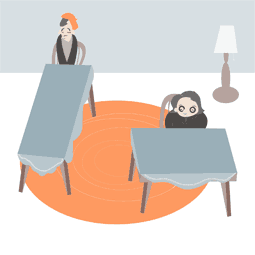


 |
||
 |
||
|
Are the two tabletops really different? The brain perceives the picture as three-dimensional, and this interpretation determines our perception. Our experience teaches us that the further we are from an object the smaller it appears. To compensate, the brain has a corrective mechanism that "lengthens" lines that appear to be pointing far away from us. Here, this mechanism lengthens the longest side of the left-hand table (making it appear longer) and the shortest side of the right-hand table (making it appear wider). A three-dimensional interpretation of a two-dimensional picture - that's also the explanation for the Size Doesn't Matter illusion. Some historical background: The illusion was created by illusion researcher Roger Shepard, who has produced many familiar "trick" images, such as the elephant with the set of impossible legs, catacomb image and the endlessly rising musical scale. Source: Links: Related exhibit:
|
||

 Twin Tables
Twin Tables